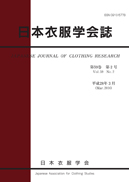
- Issue 2 Pages 71-
- Issue 1 Pages 1-
- |<
- <
- 1
- >
- >|
-
Kikuyo Hosonaga, Kazuyo Okabe, Nobuko Yamana1993 Volume 37 Issue 1 Pages 1-9
Published: 1993
Released on J-STAGE: March 27, 2024
JOURNAL FREE ACCESSThe purpose of this study was to investigate the effect of clothing pressure in the lower limbs upon the skin-surface characteristics by garment restraint.
The tests were made on eight female subjects wearing garters of several types (width, pressure-load) to answer the pressure sensation, and to measure the pressure degree of their each part on stepping action.
Then the relation between the comfort and the skin-surface characteristic by clothing pressure was studied and discussed. The results were as follows :
1) The hardness on skin-surface in the up-standing posture was more than that especially of lower leg girth, in the sitting posture which recorded the maximum value.
2) The pressure sensation in the thigh and the knee was more sensitive, and most of the subjects complained of discomfort when wearing tight garter in these parts.
3) The clothing pressure recorded high degree at the outside of thigh where the skin-surface characteristic was hard and with small movement, while that at the inside of thigh showed the opposite tendency.
4) The pressure sensation depended on the clothing pressure and the control load of garter.
View full abstractDownload PDF (3039K) -
Kiyoko Matsumoto, Takayo Anzai1993 Volume 37 Issue 1 Pages 10-22
Published: 1993
Released on J-STAGE: March 27, 2024
JOURNAL FREE ACCESSThe investigation for the consciousness towards trousers was undertaken in June, 1990. The subject of this investigation were the following : female students, male students, and their parents, totaling up to 640 subjects.
As a result of the investigation, no major differences were shown among the subjects of the different groups, regardless of the age and the sex.
Quite a few subjects recognized that pairs of trousers are practical and fashionable kind of clothes and that they are neither the male fashion nor the revolutionary clothes. This shows that the resistance or opposition against these trousers shown at the early stage is now buried in the past. Therefore, it is expected that the various kinds of more practical and functional trousers will be taken root in the culture of female clothes.
View full abstractDownload PDF (4828K) -
Michiko Nakahashi, Satoe Kiyama1993 Volume 37 Issue 1 Pages 23-31
Published: 1993
Released on J-STAGE: March 27, 2024
JOURNAL FREE ACCESSMost of foot damages are considerd to be caused by wearing unfitted shoes. However, ladies socks may also strongly tighten the toe region. In the present study, morphological examination on toe tightening by socks was made. A foot print was taken on a silicon sheet set on Pidoscope. From the foot Print ; bending angles of each toe and distances between toes were determined.
The results demonstrated that both the big toe and the little toe have been significantly bent to the inside by wearing socks and the distance between them has been shortened. Especially, this tendency was distinct when wearing support-type socks.
View full abstractDownload PDF (2481K) -
Yoko Ohta1993 Volume 37 Issue 1 Pages 32-47
Published: 1993
Released on J-STAGE: March 27, 2024
JOURNAL FREE ACCESSIn these days, the word Fashion which was Japanized to the word Fasshon has an important significance concerned with the dressing of Japanese people. In this paper, I shall try to make clear the structure of Fasshon by analyzing the views on clothing and the behaviour of women students.
The word Fasshon is used in two defferent ways : ‘Be-Fasshon’ (Fashion which exists in the society) & ‘Do-Fasshon’ (Adopting a fashion and dressing).
The factors determining the values for ‘Be-Fasshon’ are ‘A value for the model of dressing’ and ‘A value for the information given about the clothing’. Concerning ‘Do-Fasshon’, the factors are ‘A value for Keeping harmony with society’, ‘A value for spending lavishly’, ‘A value for getting a charm & self-confidence’, ‘A value for having a pleasant feeling’ ; these four factors are the same as the factors determining Oshare (Dressing smartly). Close correlations between ‘The model of dressing’ and ‘Keeping harmony with society’, ‘Charm & self-confidence’, between ‘The information’ and ‘Spending lavishly’, ‘Pleasant feeling’ suggest the reason why Fashion concept in Japan have been posessing clothing values for dressing smartly.
View full abstractDownload PDF (6584K)
- |<
- <
- 1
- >
- >|